Saturday, March 16th, 2019
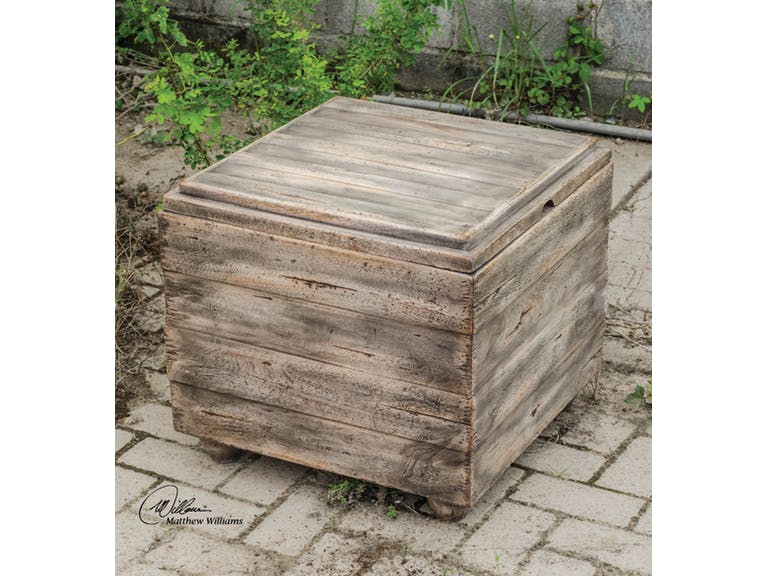
Uttermost Living Room Avner Wooden Cube Table 25603
There is a reason behind the popularity of low-impact homes these days. Apart from energy costs saved, there are health and ecological reasons as well that drive homeowners to choose to live green.
If you’ve just signed up to live an eco-friendly lifestyle, then it would be good to have a few guiding principles to help you on your new journey –
Purchase Responsibly
Green living means you purchase only from businesses that are serious about natural resource conservation. As a homeowner, you should also use energy optimally. Do this as well with your water consumption and other material use.
Buy only the products that have been certified to meet the strictest environmental standards. Always prioritize your environmental and social responsibilities as you make each and every purchase.
Buy Locally
If you have neighbors with local businesses, then support them. But make sure that they also know how to conserve energy and preserve Mother Earth.
You might think that buying locally has nothing to do with the well-being of the planet but think again.
First, food that you buy from the farmers market is fresher. You don’t just get to support the local farmers, you even improve your health and the local economy.
Compared to store-bought food, too, local foods have less transportation time. You can even drive to the nearest farmers market to pick your own peaches, strawberries, blueberries, etc.
Another upside to local purchase is the amount of packaging involved. You can bring your own reusable bags when you buy from the farmers market. As you can see, saying no to plastic is a major decision that you have to make when you want to live a green lifestyle.
Assess a Product’s Environmental Impact
If you want to be truly sustainable, product suitability and longevity must also be balanced with sources and materials that are sustainable. Be involved in the life cycle analyses (cradle-to-grave concept) of the environmental impacts of products that you buy.
Say no to products that harm animals such as alligator or snakeskin products, ivory from elephant tusks, etc.
Reduce, Reuse, Recycle
Just buy products that make use of recycled materials like salvaged timber, reclaimed tiles, recycled pet bottles, etc.
You can help protect the environment by remembering these 3Rs. Reducing means you’re willing to decrease the amount of waste that you and your household produce.
In reusing, you can think of ways that you can use something more than once. For instance, you can shred paper for your pet hamster or you can use glass jars for multiple uses.
Recycling, on the other hand, means you imagine ways to use the product again without having to buy new products. You can compost food wastes and recycle those UPS boxes after you empty them.
Be Energy-Efficient
There are simple ways to begin your energy-efficient lifestyle.
First, you can begin lowering your thermostat especially when you’re away from home. You can also seal your windows and limit your use of space heater.
Be sure to unplug appliances that are not in use and to replace the incandescent bulbs with LED lighting. You can also ask an electrician about the installation of a lighting control system. This should reduce your electrical consumption by 40%.
The 3Rs in Interior Design
And now that you know what the 3Rs are in green living, you can also apply these to your interior design.
If you have to remodel or renovate a part of your home, see if you can find materials that come from recycled sources. There is now recycled construction debris that you can use for your own construction projects.
Ask your interior designer about how to get your hands on such materials.
Tags: green living, McCreerys, McCreerys Home Furnishings, sustainability, sustainable design, sustainable home, sustainable home design
Posted in 2019 Trends, Green Living, Interior Design 101, Interior Design Elements, Interior Design Themes | Comments Off on Sustainability in Interior Design and Everything Else
Friday, February 22nd, 2019
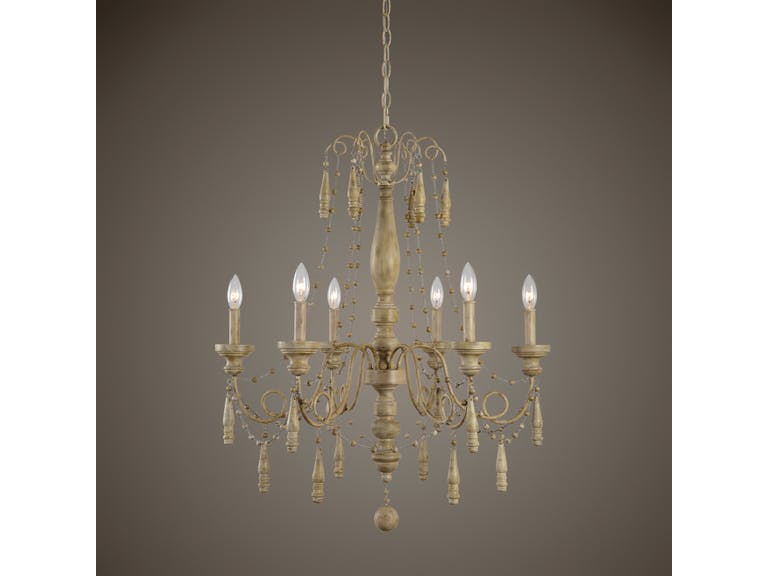
Uttermost Lamps and Lighting Marinot, 12Lt. Chandelier 21298
The dining room is a place of socialization. This is where family or friends gather to enjoy a good meal while conversing and being updated on each other’s lives. Compared to kitchens, the dining room is a place that’s meant for relaxation. This is why the décor in this area is also a lot different from the area where cooking is done.
One of the age-old ways to effectively decorate the dining room is to hang a chandelier. This is a lighting fixture that’s highly valued for its function and aesthetic appeal. This is a decorative element that can effectively enhance any space.
If you’re currently shopping for a piece that will beautify your dining room then read on for a few tips –
Know the Cost
Chandeliers will always be hot when it comes to what’s fashionable inside a home. So, if you’re updating the dining room, then know that you don’t have to spend a lot just to replace the current lighting fixture there.
If you’re changing the lighting fixture, then be sure to hire a licensed electrician. Never install an overhead light all on your own. Not only is it dangerous because it involves electrical know-how, you might also end up doing the task all over again because the wiring system might not have been placed properly.
The lighting fixture installation cost, on average, is around $418 USD. Majority of homeowners spend anywhere from $176 to $375.
Know the Different Styles
Linear. Dining rooms come in many different designs. You would want to match your lighting with the current design elements that are already in place. The simplest solution is to have a rectangular or a linear chandelier.
This kind of chandelier has a horizontal span that’s great to install over a long dining table. You can use this when your home is designed with a farmhouse look or a Mid-century modern style.
Lantern. If you want an even more traditional look for the dining room, then your chandelier style should be that of a lantern. This hangs beautifully on a vertical position, as does a traditional chandelier.
This often comes in a metal frame. You can choose from a wide array of sizes from tiny to the gargantuan. The lantern chandelier is also the best lighting fixture for a tiny dining room.
Modern. The modern style is probably the one style that stands out because it can come in interesting geometric shapes.
Find those that have metallic finishes. Chrome is one exciting finish that will give your modern home its unique look. If you’re inviting a lot of guests over, then this is the right kind of chandelier that will start conversations.
Rustic. If you’re opting for the cozy and homey feeling, then a rustic chandelier is the best choice for your dining room light. Cast iron and dark wood are common materials and are also worth investing in.
This decorative element looks great when hung over a wooden table. While most of the rustic chandeliers are linear, there are also globe varieties as well as vertical chandeliers.
Traditional. The traditional style is the safest yet still stylish choice for any unsure homeowner. Traditional chandeliers, therefore, make use of a few bulbs and some glass pieces.
Elegance is easily achieved through the traditional dining room chandelier. If you’re thinking of selling your home soon, then be sure to replace the dining room overhead lighting with this timeless choice.
Small. For people who have small dining rooms, then the lighting fixture of choice should be one that will not crowd out the rest of the design elements. Know the measurements of your dining room so that you will be able to buy the right chandelier size.
Linear chandeliers could be your best choice at this point.
Tags: chandelier types, McCreerys, McCreerys Home Furnishings, types of chandeliers
Posted in Accents, Dining Room Design, Green Living, Interior Design 101, Interior Design Elements, Lighting | Comments Off on How to Take On Your First Dining Room Chandelier Installation Project
Wednesday, February 13th, 2019

Tommy Bahama Home Living Room Flamingo Octagonal End Table 593-951: Buy furnishings that come from sustainable materials.
More and more people seem to be joining the zero waste movement throughout the world. With videos popping everyday to remind us that we can actually concoct our own deodorants and that used toilet paper can still be recycled to turn into something else entirely.
But what does zero waste mean exactly?
It could mean caring enough so that no stuff that you throw ever goes to the landfill. It could also mean saying no to using plastic.
There are now a lot of influencers who talk you into catching on with sustainable living and letting go of their garbage-filled lives. If you’re ready to live as they do, then here are a few tips that could jump-start your new lifestyle –
No Shopping Bags Please
Instead of having your newly bought items stashed inside a plastic bag, you can just bring a reusable bag with you. The lightweight kind of market bags is light enough to bring with you at all times.
Always be prepared with a reusable bag because you’ll never know when you’ll feel like shopping.
Do Bulk Purchases
Divide your shopping time between the grocery stores and the farmers’ market. Fresh produce can be gotten at the latter but they are often selling in retail. If you want to do some bulk purchase, then zero in on the supermarket. This is the place that could give you the veggies in bulk.
And as you shop, be sure to bring your reusable bags yet again. If you have to bring containers for your liquid purchases, then do so.
Buying in bulk might be more expensive at first but it could actually save you money as you keep at it. Plus you don’t have to worry about the stack of plastic bags that eventually turns into a mountain under the kitchen sink.
Use Rags and Dish Towels, Not Paper Towels
This is one of the easiest transitions that you could do. Sure, it’s convenient to just wipe and throw but you can commit to a better solution. If you’re not used to washing rags, then slowly wean yourself from the paper towels.
You can begin by hiding the paper towels and then getting some unused shirts that you could begin using as a rag.
Cloth napkins can also be used for everyday cleanups.
Store Food in Metal or Glass Containers
There are many reasons why you should pick a glass container instead of a plastic one. Glass is safer, it is better able to hold heat in, and it is transparent and a lot prettier than plastic.
Glass is also a lot cleaner compared to plastic containers.
Practice the FIFO Method
The FIFO or first-in-first-out food storage method is efficient because it ensures that no food goes to waste. Older products, which were bought earlier, are used or consumed prior to the newer ones.
There are just five simple steps to follow for this method –
Make Your Own Stuff
This might not be that easy. You could begin with some kitchen beauty remedies such as honey or ice cubes instead of the usual facial cream. Look for DIY soaps, shampoos, and cleaners.
Cut Down on Your Trash
Take a careful look inside the garbage bags and analyze how you could cut down on the contents. If the bin is already brimming with cartons and plastics, then you know what to do.
Vow to say no to plastic the next day and recycle the things that you could.
Tags: McCreerys, McCreerys Home Furnishings, minimalism, sustainable lifestyle, sustainable living
Posted in Green Living, Interior Design 101, Interior Design Elements | Comments Off on From Neophyte to Recycling Pro
Wednesday, October 24th, 2018
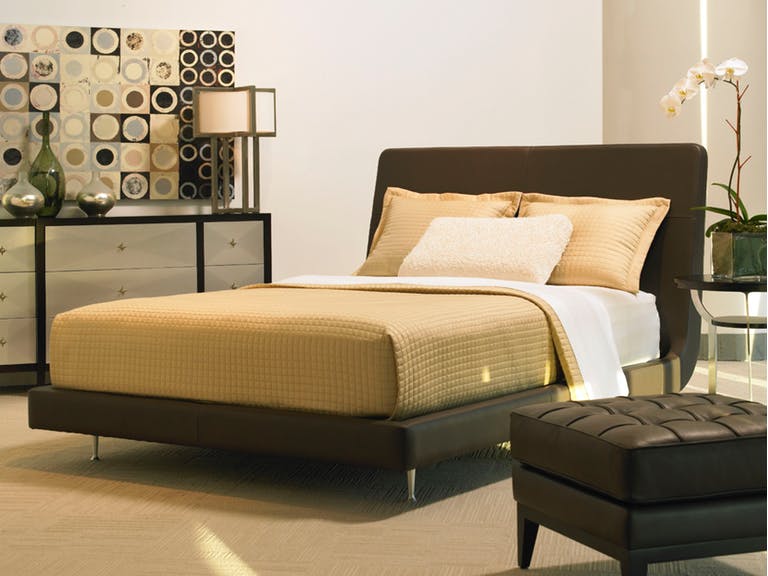
Notice the straight and simple lines of thisAmerican Leather Bedroom California King Bed MEN-BED-CK.
Minimalism is a word that is recently taking the world by storm. This carries with it a lot of ironies since it means living in a stressful world but with less stuff.
Books, documentaries, and podcasts have all been raving about minimalism and how it can actually alter the life of someone who is willing to free-fall.
A lot of minimalists swear by the philosophy of living a life that’s free from excess and worldly possessions. They testify on how having less stuff actually gave their lives more meaning.
It’s No Fad: The Benefits of Minimalism
You may think that minimalism is just a millennial fad but it is a lot more than this. When done with the right reasons, it is a means to make your life more significant.
So what are the benefits of living a minimalist life?
First, those who sign up to live a minimalist life get rid of their financial worries. They also get rid of all forms of clutter in their lives. They learn how to classify the things that they really need from the things that do not add value to their existence.
Minimalists also spend more time on experiences and less time in the acquisition of material things. Eventually, they feel a lot happier and freer.
Minimalism Means Green
Minimalists also sign up to become green enthusiasts. In fact, sustainable living or green living is equated to minimalism. Green living means buying less and having less waste.
Minimalism also means seeing consumerism for what it is. This has contributed to the issues on earth’s climate and other such problems. If you want to live ethically, then minimalism is the best way to go.
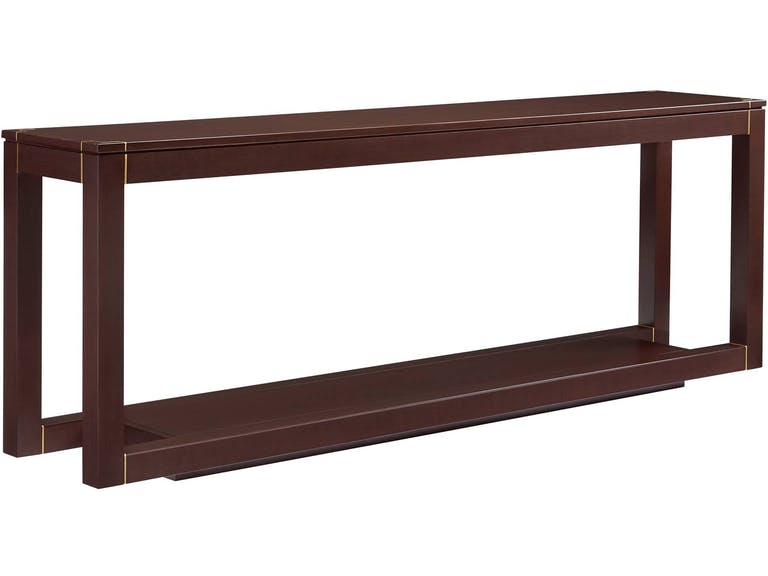
Stanley Furniture Living Room Floating Parsons Console Table 704-45-05
Start Now
So how do you begin living a minimalist life?
First, learn to reduce, reuse, and recycle. You must say no to excessive purchases. You must also promise to decrease the amount of waste that your home produces. And you must swear to recycle and reuse stuff. Composting is something that you also say yes to.
As a minimalist, you must also unplug. Save energy and money when you unplug those electronic devices that consume electricity even when they are just plugged.
Assess your possessions. Find something that you will keep (this is typically something that you will use in the next three months). If you pick an object that you won’t use continuously in the next three months, then it’s okay to finally let go.
This 90-day test is far from easy, though. For instance, you may not use your book collection in the next three months but this does not mean that you should let throw or sell them straightaway.
Another tip here is to live in a smaller place. More probably, you won’t need a big apartment with less stuff. Plus, studio apartments and condo units are a lot cheaper than renting a huge house. Tiny homes are quite popular these days so it’s time to join the bandwagon.
Smaller units also require fewer utilities. Just compare the heating needs of a bungalow with that of a studio apartment.
Another step in minimalism is to buy fresh food weekly. Always buy in bulk so that you’d save more.
Own less furniture, clothing, and appliances, too. This means owning the pieces that are right. Always prioritize quality over quantity.
Buy a laptop that will last a number of years; this has to be a piece that won’t have you worried that it could break down any time. As for clothing, buy the pieces that will also last many years. These are the staple pieces such as a pair of jeans, a few shirts, and a pair of boots.
As for furniture, find the pieces that have multiple uses (e.g. an ottoman that is also a storage unit).
Tags: McCreerys, McCreerys Home Furnishings, minimalism, minimalist, minimalist design, minimalist interiors, minimalist lifestyle, minimalist living, minimalist space, minimalist style
Posted in Green Living, Interior Design 101, Interior Design Elements, Interior Design Themes | Comments Off on The Holistic Minimalist
Friday, October 5th, 2018
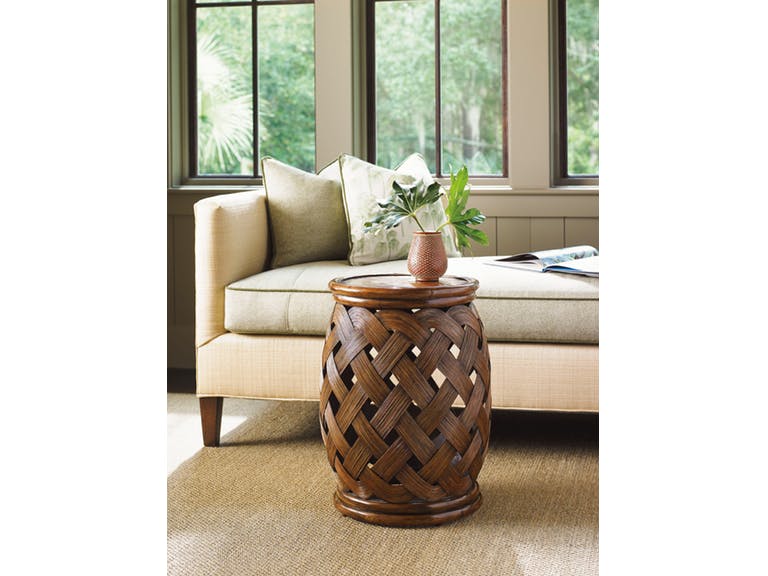
This room is green because it has wide, open windows and it features this Tommy Bahama Home Living Room Hibiscus Round Accent Table 593-953.
Green home is a term that could mean so many different things. There are those who consider a home green only if the Energy Star standards have been met. There are those, however who don’t just depend on certifications in order to define a certain home green.
Generally, though, a green home is one that uses less energy. This is also one that’s been built using sustainable materials. And with the leading U.S. wastes already including non-industrial wastes such as demolition and construction wastes, it’s about time that green builders take center stage.
Find the Alternatives
The bulky building materials that are often used in many construction projects throughout the nation comprise the biggest carbon footprint. There is chance, though, because green builders, are seeking ways to give more options. They are now presenting materials that are recycled, locally sourced, reused, durable, and renewable.
The wisest homeowners have taken heed. From the usual aluminum window frames, there are now those that choose local wood as a material. The rapidly growing bamboo plant is also now highly favored among Zen enthusiasts.
It’s All About Energy Efficiency
Now let’s talk about greenhouse gas emissions. It is wrong to presume that only industrial plants emit these harmful gases. Even households can contribute to the problem and U.S. households have been very busy.
There are homeowners who take part in saving Mother Earth by installing only the energy efficient appliances. There are also those who now use solar panels. Yet energy efficiency isn’t the only thing that can make homes sustainable. Zero energy homes could still use steel, concrete and bricks on an environmentally sensitive area and then they become unsustainable in the process.
Consider the Location, Too
Green homes are also often built on developed lands. This is so the environmental impact is reduced if not totally brought down to zero. There is nothing green about sprawl because they eat up a lot of green space.
Another way to consider your home a green home is to build it in close proximity to your school or work so that you won’t have to spend a lot of energy on transportation.
Plant Shade Trees
Planting deciduous trees on all sides of your home will provide the maximum amount of shade. You just need to carefully plan as well as design where the trees would be specifically planted.
Going green through tree planting is another good way to save energy all year round. Imagine a cool home even during summer. And during the coldest months, these trees can also help your home weather the winter winds. You then reduce the heating cost.
Once you’ve decided to plant shade trees, it is best to inspect all around your home first. Determine which walls and windows receive the most amount of sunlight. The east and west sides should be provided with shade since these sides receive 50% more light compared to their south and north counterparts.
Be sure to plant these trees close to your house so that they will have ample room to grow out to their full height and also for proper air circulation. A tree that’s been planted 10 feet away from your house wall will eventually shade that area four times longer than one that’s been planted 20 feet away.
If you have limited space to plant trees, then you can always go for shrubs and vines. Use trellises to shade the walls as well as the windows. Examples of vines that will provide you with year-round shade is the Confederate Jasmine.
Design and Size Also Matter
Yes, size does matter because bluntly put, bigger homes have a larger physical footprint. It is essentially more difficult to maintain a 5,000 sq. ft. home compared to a 1,500 sq. ft. one.
As for the design, it is best to go for the already energy efficient ones such as the passive solar or passive houses.
Tags: green home, green living, McCreerys, McCreerys Home Furnishings, sustainable home
Posted in Green Living, Interior Design 101, Interior Design Elements | Comments Off on Do You Have A Green Home?
Wednesday, July 11th, 2018
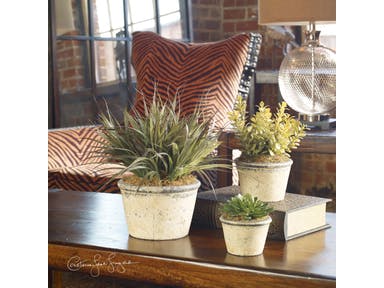
Bring in the freshness of these Uttermost Accessories La Costa Greenery, Set of 3 60115 into your home.
For many centuries, homeowners have been bringing in the beauty of nature into their habitats so that they will feel more relaxed and calm indoors. Humans also naturally gravitate towards Earth’s resources because they are, after all, a huge part of Mother Nature. If you have been thinking of ways to bring the beauty of the outdoors to your home, then here are some inspiring suggestions –
Tranquility Is Key
One of the leading reasons why man is inherently nature-loving is because he feels a connection to nature. So it is obvious that people would prefer cotton, wool or leather more than synthetic materials. Picking the materials that resonate the personality of the stylist is the first step towards a nature-inspired home.
Since the look of your home depends on your personality, then it’s up to you if you like the rugged beauty of rock walls right inside your kitchen. Or you simply prefer the sophisticated look that dark mahogany furnishings offer.
Just pick the natural elements according to your style and how nature best describes you. Or if you want to really be nature-inspired, then go for things that are organic.
There is this ongoing trend wherein homeowners now prefer organic bedding and sheets over the synthetic ones. Just design the rooms in your home according to the elements that make you feel calm and soothed.
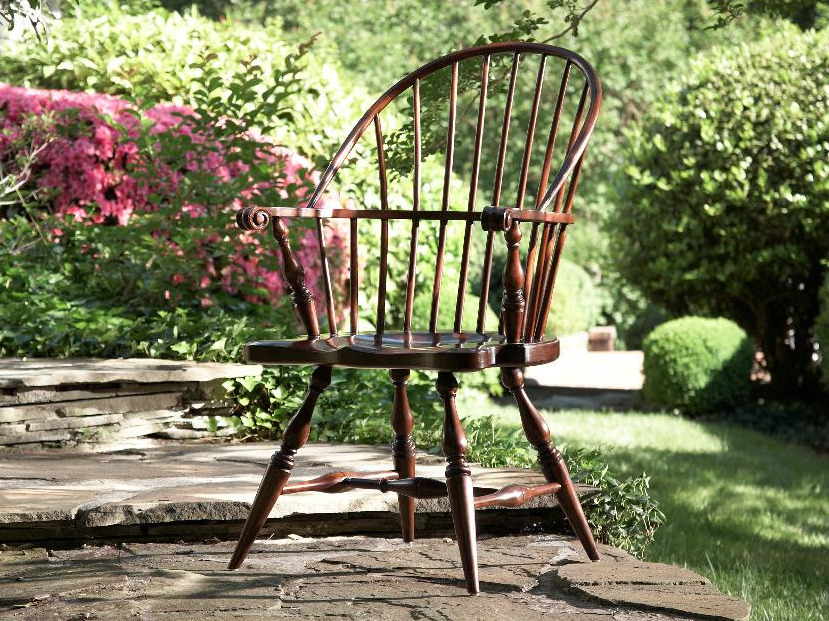
Wood and nature are beautifully fused in this Rhode Island Windsor Arm Chair (American Cherry Collection of Fine Furniture Design).
The Wood Element
Wood is a leading material in construction. It is favored by many homeowners because of its rustic beauty and depending on the finish that it is given, it can provide a shiny, gorgeous appearance or a rustic appeal because of its natural grains and knots.
If you decide to use wood in your home then you have also decided to bring warmth and coziness in.
Wood furniture is also popular because they are crafted to last. They are beautiful especially when created by the best craftsmen. Different species come with different looks. Even reclaimed wood is now being used to construct ceilings, flooring, and furniture.
If you’re worried that wood is just for the traditional home design, don’t be. Wood can be made into a contemporary piece, too, just as long as you use minimal lines in crafting furniture. The sleeker the wood furniture, the more contemporary it is.
Consider Brick
Do you remember the earliest techniques of making brick? Back in the day, brick-making involved the use of clay, mud, water, and fires in the highest temperatures. These elements bring about the sturdy construction material that we now know as brick.
Many natural materials still cannot measure up to the rustic beauty of brick. After all, bricks have a charming color and pattern which are perfect as a backdrop to both rural and urban dwelling places.
Just choose whether to leave the bricks in their natural state or to paint them.
The Natural Bathroom
One of the rooms that can naturally adapt to a nature-inspired theme is the bathroom. Where else can you feel more rejuvenated and relaxed than this room? Have a working heating and water system set up in this room. To make the room even more rejuvenating, be sure to use only natural materials such as wood walls and stone flooring.
You can complete the ambiance by adding natural daylight which closes to provide ambient lighting in the evening.
Fresh Flowers Galore
Don’t go for the artificial flowers because you are no longer in the ‘80s. Use fresh flowers in vases and bring in potted plants, too. Succulents also have an awesome way of freshening up the look of a room without even trying too hard.
Tags: McCreerys, McCreerys Home Furnishings, nature-inspired design, nature-inspired home, organic home design, organic home interiors, organic living
Posted in 2018 Trends, Green Living, Interior Design 101, Interior Design Elements, Interior Design Themes | Comments Off on Living Organically: How to Set Up the Nature-Inspired Habitat
Tuesday, June 26th, 2018
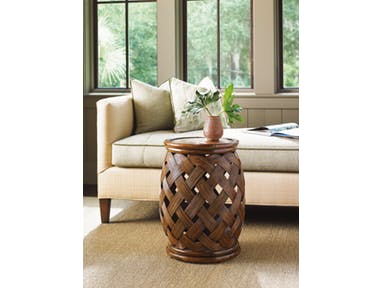
The Tommy Bahama Home Living Room Hibiscus Round Accent Table 593-953 is made from bamboo, a sustainable material. Notice also the open, airy windows which let in natural light during the day, thus, eliminating the need to turn on lights during that time.
Your home is where sustainability should begin. From the furnishings to the finishes, choosing green products as well as practices can improve your home’s design. Deciding to live in a home with zero environmental impact is a good thing to do. Keep up with such good decisions and, now, let’s learn how to set up a sustainable interior design –
Minimalism Is Key
There are a few rules to learn if you’re a beginner minimalist. These can be summarized in seven easy steps –
First, learn to let go. This means looking for the dumpster and throwing all the things that you have not been using for six months or more.
Second, stop denying that you have a hoarding problem. No, you don’t have a space problem, you only have a stuff problem.
Third, if you have decided to live sustainably, then you should be willing to begin. Don’t wait for inspiration from someone else. Be able to motivate yourself to start.
Fourth, write down all the things that you want to finally get rid of including debt, stress at work, at many more. Once you write down these things, you’ll realize just how simple life really is.
Fifth, discard any duplicates. If you have boxes of magazines and DVDs, scour through them and keep only the ones that you are going to use in the next 30 days. For the rest of the boxes, have them thrown.
Sixth, declutter. Do this from the countertops to the kitchen islands, to your nightstand and even in that drawer in your bedroom. A clean, clear environment is as minimalist as you could ever get.
Seventh, have less of everything – less clothing, fewer shoes, fewer travel essentials, less eating out.
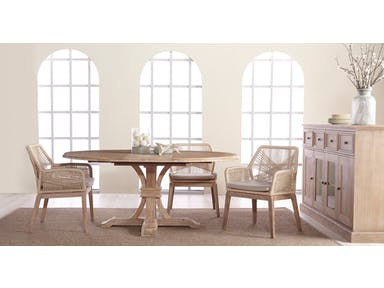
Orient Express Furniture Dining Room Loom Arm Chair
Use Only Eco-Friendly Materials
Gone were the days when eco-friendly materials were costly. Now, more and more manufacturers are able to meet the demands for green yet affordable products. If it’s possible, hire a sustainable interior designer so he or she could help you pick the right materials to use such as bamboo, rattan, etc.
Shop with Care
Be able to shop with confidence. Say no to plastic products and start saying yes to paper coffee cups or the usable ones, recycled toilet paper, biodegradable waste bags, organic clothing, solar power, green clothing, and furniture built with sustainable materials.
Learn to Save Energy
There are many different ways to save energy in your home ranging from the simplest to the most intense. You have to adjust your behaviors each day. Turn off appliances that are not in use (take baby steps first). You can also choose to do manual tasks such as drying your laundry the old-fashioned way or washing the dishes by hand.
Another energy-saving tip is to replace the light bulbs with LEDs or light-emitting diode bulbs. These may seem expensive at first but you will save about 25-80% electrical energy in the process. These bulbs also have a longer life=span compared to traditional light bulbs.
Apart from purchasing LED bulbs, you should also consider investing in energy-efficient appliances. These operate at 9-25% less energy compared to the traditional models. Look for the Energy Star label in all your appliances. This label guarantees that this appliance will consume less electricity.
Have a smart thermostat installed. This programmable thermostat can be automatically turned off to reduce cooling or heating during certain times of the day. The average thermostat can save you about $180 annually.
Have energy efficient windows installed. Did you know that your home loses about 10-25% of heat when you only have traditional windows? In order to prevent heat loss, replace the single panes with double-panes.
Tags: McCreerys, McCreerys Home Furnishings, sustainability, sustainable home design, sustainable interior design, sustainable materials
Posted in Green Living, Interior Design 101, Interior Design Elements, Interior Design Themes | Comments Off on What Is A Sustainable Interior Design?
Saturday, November 25th, 2017
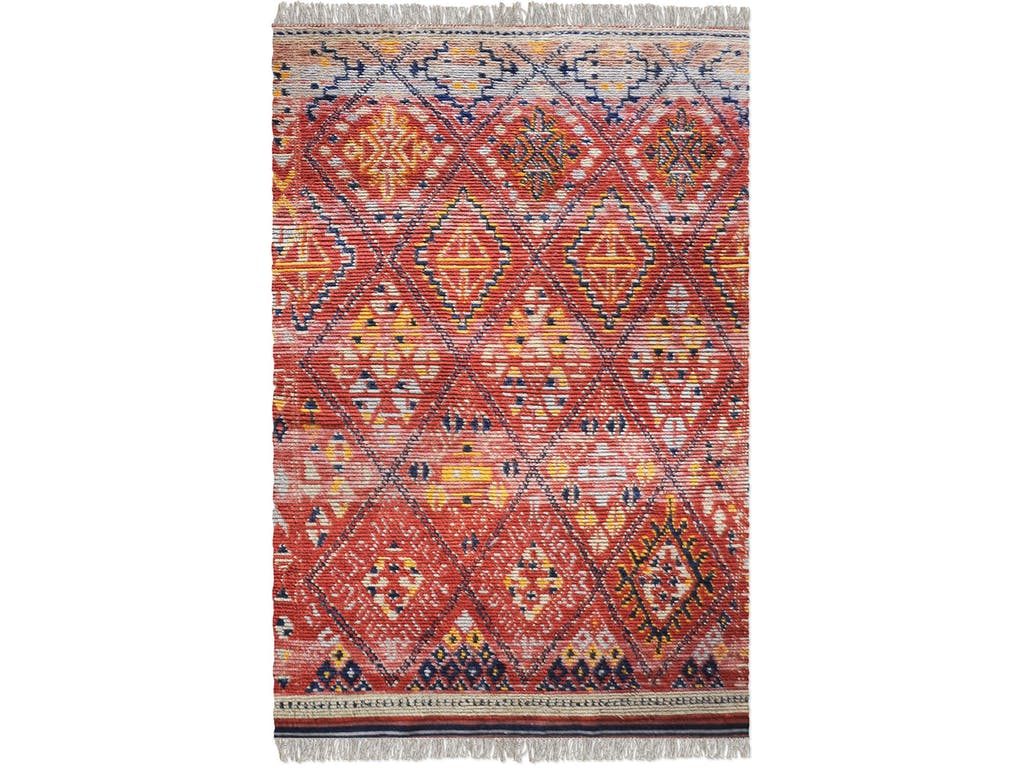
Uttermost Floor Coverings Balgha Red Rug 70029 is both functional and fashionable.
Taking the step to improve the energy efficiency of your home offers a plethora of benefits for you and your household. You do not just contribute to a fresher and greener community, you also get the added benefit of reducing your household expenses.
Whether you own or rent a home, and whether or not renovation is affordable for you, there are various ways to begin switching to a greener home. Smart energy consumption should be your family’s new mantra.
A Cool Roof
You can always begin with a cool roof. This is no less than your first line of defense against the ravaging elements outdoors. Make sure to have a roof that reflects the rays of the sun. Doing this will help reduce the heat that emanates from your roof, thus, improving the overall coolness of your home – no need to turn on air-conditioning.
The cool roof can be done by painting it with a reflective color or the use of tiles (the latter offer a different level of coolness both figurative and literal). Shingles and sheet covering can also have the same effect.
It could be costly at first since you have to add a few features to your roof but it is going to save you a lot of money on energy bills so it’s more than worth it in the long run.
Constricted Doors and Windows
Do not let cool air escape. One effective way to do this is to have tight doors and windows.
If you have aluminum window frames, then it’s time to change them. Vinyl or wood is a better alternative.
As for the windows, you can try the low-E (emissivity) glass panes. This is a kind of energy efficient glass that was specifically designed to prevent heat from escaping through the windows. These come with an invisible coating which can reduce heat transfer and, eventually, reduce your carbon footprint.
Use Energy-Saving Appliances and Fixtures
Everyone seems to be signing up for the energy-saving bandwagon. You can see this with the constant improvements on gadgets and equipment, with each one surpassing the first in terms of energy consumption.
Speak of using less power, you must also check the Energy Star rating of each appliance. This symbol is backed by the government where people use products that are energy efficient and can help save money.
The label of Energy Star is supposed to symbolize the reduction of greenhouse emissions and pollutants brought about by the misuse or inefficient energy use. Check out the list of energy efficient lighting, air-conditioning units, and electrical appliances.
Just Do It
Just like the Nike campaign, you can always begin any endeavor by just doing it, especially when you are stuck with what you have. If there is no way, at the moment, to change the appliances and fixtures that you have at home, then you can follow these quick tips –
Tags: energy efficient living, Energy Star, energy-efficiency, green home, McCreerys, McCreerys Home Furnishings
Posted in Green Living, Interior Design 101, Interior Design Elements | Comments Off on The Energy-Efficient Household – Make It Yours
Saturday, September 16th, 2017
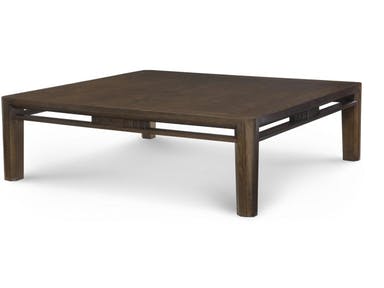
Century Furniture Living Room Akimi Coffee Table AE9-601
Did it ever occur to you that most Japanese homes are actually small? While this is so, you would not hear Zen enthusiasts ever complaining of not having ample space. And even when these homes are situated close to one another, natural light, safety, and privacy are all still kept intact.
Most urban Japanese homes are not single-family homes. In fact, their apartments are small yet you will still see the beautiful traditional features like step-up entryways and the deeply-relaxing soaking tubs.
Even Westernized Japanese style homes have one Japanese room complete with tatami flooring. This means that the traditional Japanese elements are still widely incorporated by many Western architects. The essential concepts are the following –
Gates
When you go to Japan, one of the things that you would immediately notice are the gated entryways. This is because many residential streets do not have sidewalks. The line of demarcation, therefore, rests on the property’s gate.
The gate is also traditionally roofed especially in Kyoto, Japan. It is also common to find cherry trees in the garden that greets the visitors once they are welcomed into the property.
Walls
Since there are gates, naturally, there are walls. The Japanese always make their properties secure and private so they set up walls right at the property lines. The most common material is the concrete block whether the home is situated in a quaint village or in a city.
There are also bigger homes with stone walls that are topped with wooden fences. There are even those that are topped with actual trees.
Tiled Roofing
Japan is constantly bombarded with rain, hence, their roofs are designed for water drainage. The broad eaves allow the opening of exterior doors without letting in unwanted rain splashes.
Step-Up Entryway
This is that transitional space between the interiors of the home and the outdoors. This is that very spot where the shoes are exchanged for the slippers. Called the genkan, this is also where a shoe cupboard can be placed also some decorative objects like art, flowers or ceramics.
This area may also face the tokonoma or the alcove where artwork or scrolls are prominently displayed. Ikebana or flower arrangements may also be featured there.
North-South Views
Japanese houses are often set up north-south, meaning, the house gets a steady amount of sunlight during the day. The outdoor views are often mountains or lovely water features.
Would you believe that natural light is actually a human right in Japan?
Sliding Doors
The lovely louvered doors are also essential parts of every Japanese home. These also feature slatted windows which are common in live-work homes.
Wood and Straw Everywhere
No Japanese home can be called such without an element of wood in it. Japanese homes often stain their wooden features but they never paint them. It is crucial to feature the wood grain insomuch that they can even feature an entire tree as a roof beam.
Another important material in Japanese interior design is straw matting. On any tatami flooring, a type of grass called igusa is woven. This is used to keep the house cool during the summer months and warm during winter.
Straw matting can be a tad costly but they are known to last for many, many years. Remember how the Japanese never use their dirty shoes indoors? This is the reason why the tatami flooring remains undamaged for many years.
You can also follow this same concept. To add to the Zen atmosphere, you can also bring in standard rectangle mats. Get the ones that have black cloth or brocade edges.
Multi-Purpose Rooms
Traditional Japanese homes also have multiple purposes for every room. The futon or traditional bedding can be folded during the day to reveal a larger room where people can relax, sit or even dine.
Tags: Japanese design elements, Japanese interior design, Japanese interiors, Japanese style, McCreerys, McCreerys Home Furnishings
Posted in Green Living, Interior Design 101, Interior Design Elements, Interior Design Themes | Comments Off on Traditional Japanese Habitat: Where Privacy, Nature, and Harmony Combine
Friday, September 15th, 2017
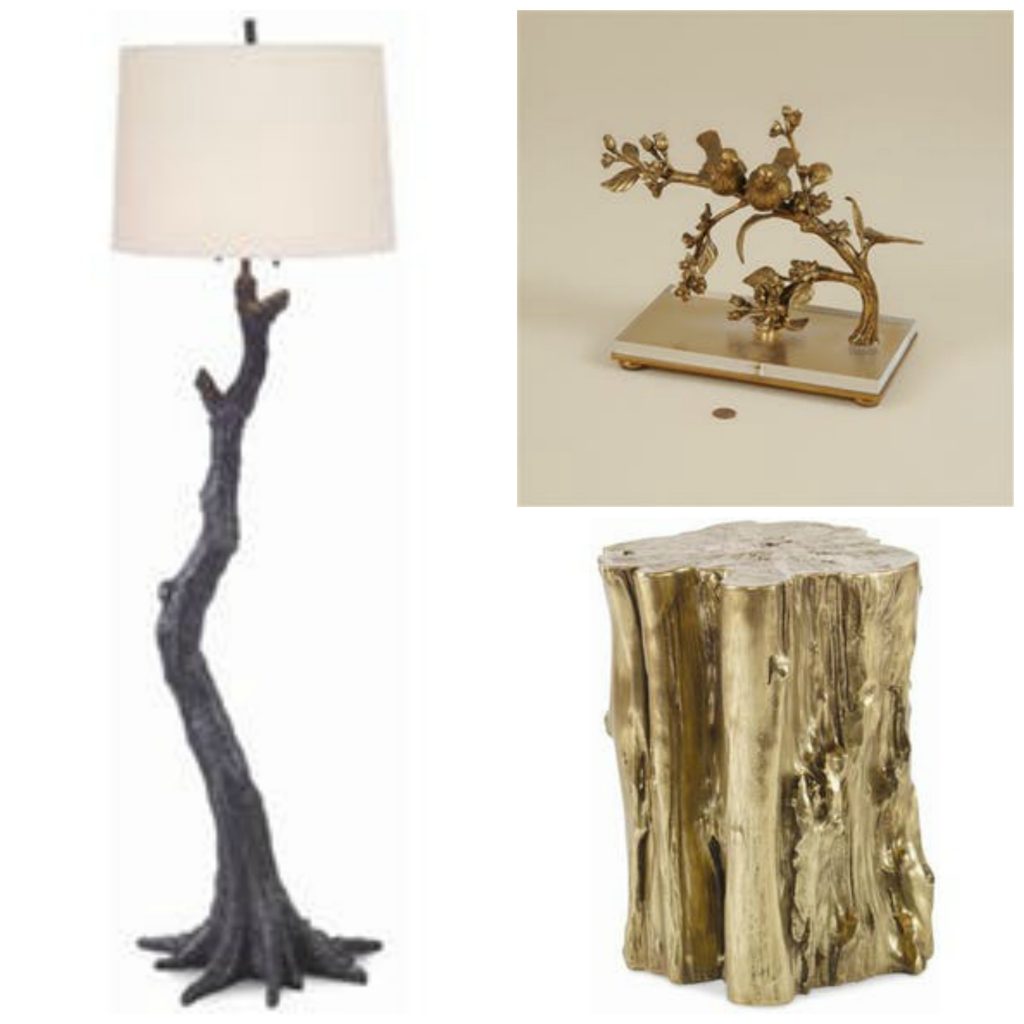
Counterclockwise from left: Century Furniture Lamps and Lighting Cambrium Zinc Floor Lamp SA8290; Maitland-Smith Accessories Classic Finished Cast Brass Birds Sitting On Tree Branch, Acrylic Base 1054-309; and Century Furniture Living Room Yew Small Brass Side Table SF5636. In the absence of live trees, then opt for these trunk or branch-like decorative elements.
What could be a more perfect architecture for a home than Mother Nature herself? Trees can provide just the right amount of an outdoorsy feel even as the seasons change outside.
Trees, apart from being beautiful also offer shelter and shade. Do you remember your childhood when you spent a good amount of your time playing inside a tree house? No? Then this is the perfect time to add something green to your habitat.
These days, trees can be kept close to your home or you can even choose to bring them indoors. These trees can be integrated into your home’s architecture or interior design.
You can choose to use mature trees or new plantings.
When Using Existing Trees
The primary way of having trees integrated into your home is to construct a room around it. Find a licensed building architect who can help you design your unique home. This licensed professional may also collaborate with a landscape contractor, landscape architect, or a certified arborist (tree surgeon).
This team will ascertain that the tree will not be injured during construction. After all, it is crucial that you protect any existing trees so that when you integrate them into your new home or building, that they can still give you a natural, rustic look.
Evaluate
It is crucial to evaluate what kind of trees you will be building around. There are trees that are resilient and, unfortunately, there are also those that are more sensitive and are easily affected by the stresses of their environment. Again, you will need an expert to evaluate whether the tree is suitable to be used as a column or a decorative piece in your home.
An arborist or any tree expert should be able to help you make this crucial assessment. This expert is also likely to remain involved during the construction. This is so the tree’s health is monitored on a regular basis.
The California sycamore is one kind of mature tree that can be easily enclosed in a new construction.
Where Are the Roots?
It is also important to know the root location so that you can protect the system from being damaged. More often than not, the root system is determined by the tree trunk diameter also the drip line from the trunk up to the first level where the branches grow.
For a more accurate measurement, you can also rely on air-spade technology which can blow the soil away to show the major roots. Root injury can result in the death of the whole tree so be careful.
Where’s the Water At?
And since you will be keeping a tree inside your home, it will still need the usual requirements for photosynthesis – sunlight and water. You can provide these by having glass that opens up to the sky. You can also have a timed irrigation system that would water the roots under your home.
Function or Art?
Most of the time, a homeowner integrates a tree into his home because it has special memories. If not, the next best reason is aesthetics. It could be that the tree will provide an artistic form or character into the house.
Trees also have cooling properties so they can even help during those summer months when your home needs extra cooling.
When Using New Trees
Indoor planting areas can also be constructed. This is a container system that has soil and windows where the sun’s rays can pass through. Remember, again, that your growing tree will need water, soil, air, and sunlight.
Consider also the growing habits of your chosen tree as well as its maintenance requirements.
Tags: decorative trees, indoor tree, indoor trees, McCreerys, McCreerys Home Furnishings, tree columns
Posted in Architectural Elements, Green Living, Interior Design 101, Interior Design Elements | Comments Off on Trees as Decorative or Architectural Elements: How to Integrate Tree Trunks in Homes
© McCreery's Home Furnishings | All Rights Reserved | Privacy Policy